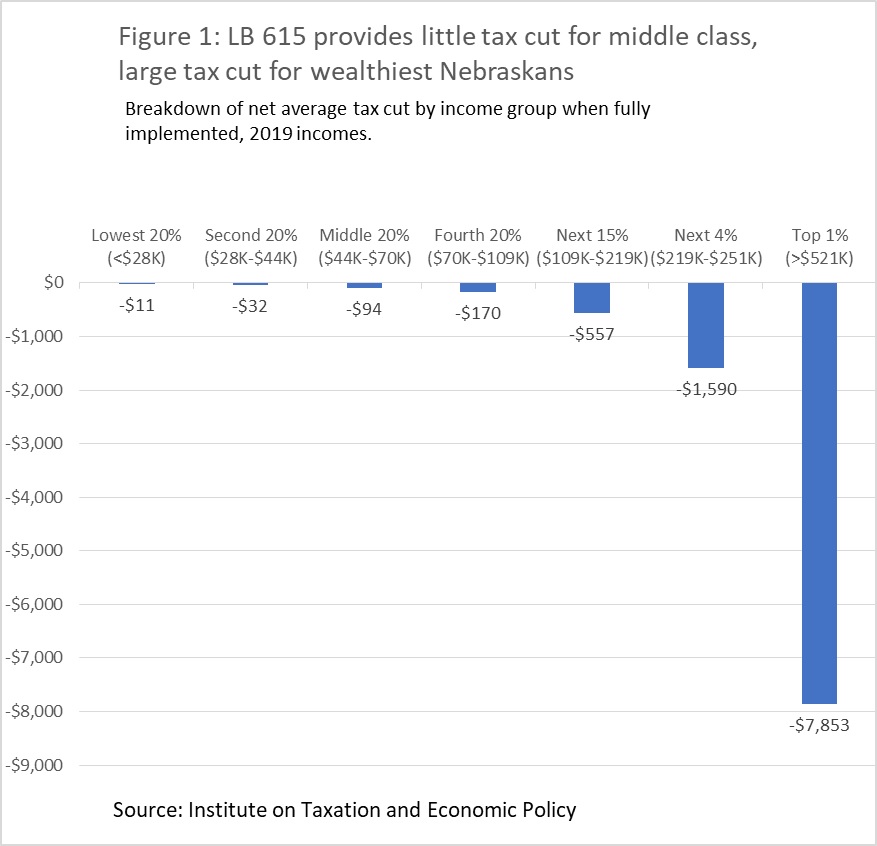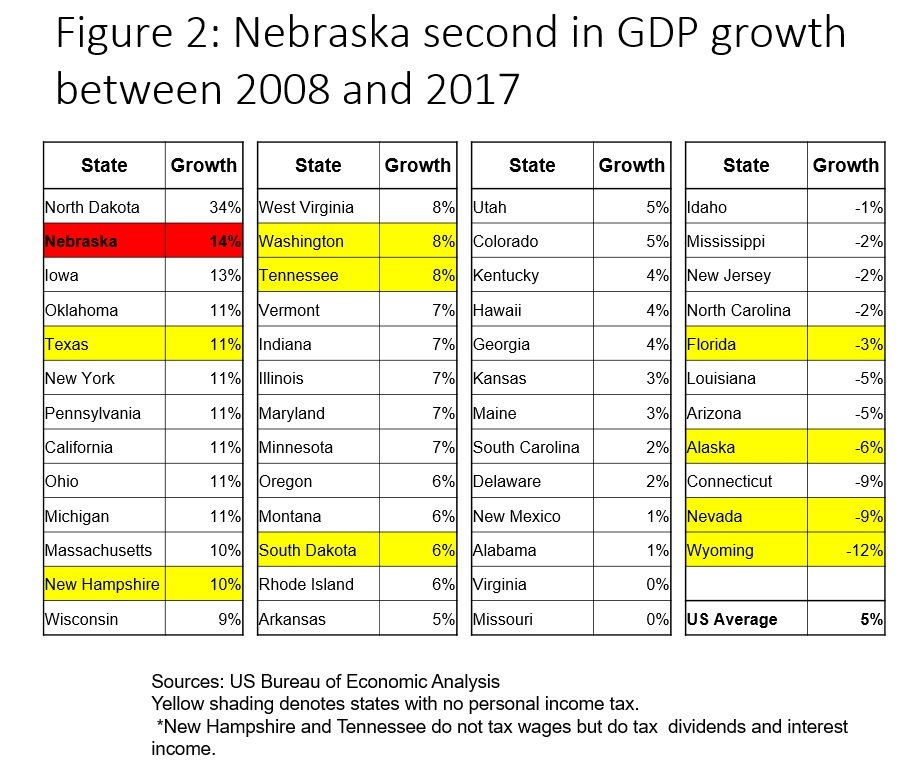Policy brief – LB 615 prioritizes income tax cuts, depletes cash reserve
(EDITOR’S NOTE: Download an analysis showing how LB 615 would affect our Real Taxpayers of Nebraska.)
LB 615 provides large tax cuts to wealthy Nebraskans, does little for the middle-class or small businesses and does not provide meaningful property tax relief. The bill also would deplete the state of revenue needed for schools, public safety and other key services at a time when state revenues are lagging amid what could be the beginning of a long run of budget shortfalls.[1]Furthermore, the measure would repeatedly draw down our cash reserve and put our state at even greater risk of cuts to vital services should the economy take a downturn.
What LB 615 changes
LB 615 cuts the top personal and corporate income tax rates – which are presently 6.84 percent and 7.81 percent respectively — to 5.99 percent using a series of triggered tax cuts. The tax cuts would be “triggered” when state revenues are projected to grow at least 3.5 percent and the cash reserve balance is at least $500 million. A $75 million transfer from the cash reserve to the Property Tax Credit fund also would be triggered when these conditions are met. LB 615 does not fund its tax changes with offsetting revenues.
Wealthiest Nebraskans get largest tax cuts
Institute on Taxation and Economic Policy (ITEP) data show that under LB 615, a Nebraskan in the top 1 percent of incomes would receive an average tax cut of about $7,853 a year; a middle-income earner would receive about $94 annually on average; and the lowest-earning taxpayer would, on average, receive an $11 tax reduction. (Figure 1) About 79 percent of LB 615’s income tax cuts would go to the highest-earning 20 percent of Nebraskans with annual incomes greater than $109,000. Furthermore, about 27 percent of the tax cut will go the wealthiest 1 percent of Nebraskans, who on average earn about $1.3 million annually.
Revenue loss would be significant and much of the tax cut would benefit non-residents
Nebraska Department of Revenue data show that when fully implemented, LB 615 would annually reduce the general fund by about $320 million[2] and would transfer $75 million from the cash reserve in years that tax cuts are triggered. ITEP data show that about 30 percent of the total tax cuts would benefit non-Nebraskans who own property or stock in Nebraska companies.
LB 615’s property tax cuts are temporary while income tax cuts stay in place
LB 615’s property tax reductions only occur in the years a $75 million transfer from the Property Tax Credit is triggered. The bill’s income tax cuts, however, stay in place and continue to hold income taxes down each year once they are triggered.
Revenue triggers are not sound tax policy
Revenue triggers like the one proposed in LB 615 set tax cuts on autopilot based on arbitrary levels and don’t allow lawmakers to respond to state needs in economic slowdowns or natural disasters. A tax cut trigger in Oklahoma caused an income tax cut in 2016 just as oil prices plummeted. This contributed to a budget crisis in which nearly one third of Oklahoma’s school districts moved to four-day school weeks.[3] LB 615’s trigger is based on projected revenue growth – not actual revenue growth. If the trigger proposed in LB 615 had been in place in Nebraska since 2001, several tax cuts would have been implemented, including one during “The Great Recession.” In two cases – 2008 and 2016 – tax cuts would have been triggered when actual revenue growth turned out to be negative.
Tax cut not likely to deliver on economic promises, would hinder key investments
Income tax cuts like those included in LB 615 have been proposed in the name of economic growth. Academic research, however, fails to find a consensus regarding a link between income tax cuts and economic growth.[4] For its part, Nebraska economically outperforms most states with lower or no income taxes and had the second-highest GDP growth between 2008 and 2017. (Figure 2)
LB 615 also would do little to help small businesses. The median income for individuals employed at their own incorporated businesses was $43,900 in 2016. For an unincorporated business this figure was $25,730. An individual earning $43,900 would see an income tax cut of $57.20 under LB 615 after accounting for the standard deduction. An individual earning $25,730 would receive no income tax cut.[5]
The revenue losses created by LB 615 would, however, impede Nebraska’s ability to invest in real economy builders like schools, public safety and infrastructure and also would prevent Nebraska from taking real steps to address our high reliance on property taxes to fund schools and other vital services. In their research of the effect of tax cuts and budget cuts on economies, Wichita State University professors Arwiphawee Srithongrung and Ken Kriz found the negative effects of funding cuts typically significantly outweigh any positive economic impact of tax cuts.[6]
Bill depletes cash reserve when we should be building it up
LB 615 would draw down Nebraska’s cash reserve fund at a time when lawmakers have deemed rebuilding the fund a priority.[7] The $500 million level that would spark triggered tax cuts under LB 615 would be equivalent to 11 percent of FY18 general fund receipts – which is well below the 16 percent level recommended by the Legislative Fiscal Office. A strong cash reserve helps prevent major cuts in economic downturns. This is particularly important considering a federal stimulus package is unlikely to occur the next time we enter a recession, which many economists predict will happen in 2020.[8]
Conclusion
LB 615 poses serious budgetary risks with little guarantee of economic reward. It also fails to provide meaningful property tax relief. Furthermore, it is fiscally irresponsible to be considering large, unfunded tax cuts and large withdrawals from the cash reserve in the face of major budget uncertainty at the state and federal level. And while LB 615’s tax cuts are unlikely to strengthen our economy, they will harm Nebraska’s ability invest in real economy builders, address pressing state issues like corrections and could leave us faced with dire consequences should the economy take a downturn.
Download a printable PDF of this analysis.



